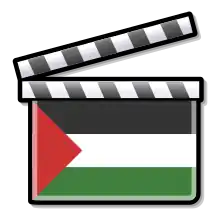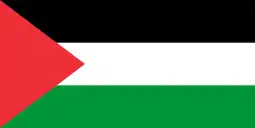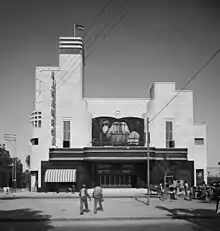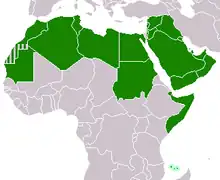| Cinema of Palestine | |
|---|---|
 | |
| No. of screens | 2 (2007)[1] |
| • Per capita | 0.1 per 100,000 (2007)[1] |
| Number of admissions (2007)[2] | |
| Total | 64,026 |
| Part of a series on |
| Palestinians |
|---|
 |
| Demographics |
| Politics |
|
| Religion / religious sites |
| Culture |
| List of Palestinians |
Cinema of Palestine is relatively young in comparison to Arab cinema as a whole. Palestinian films are not exclusively produced in Arabic and some are even produced in English and French.[3] Elia Suleiman has emerged as one of the most notable working Palestinian directors.[4]
History
The first period: The beginning, 1935–1948

The first Palestinian film to be made is generally believed to be a documentary on King Ibn Saud of Saudi Arabia's visit in 1935 to Palestine, made by Ibrahim Hassan Sirhan (or Serhan), based in Jaffa.[5][6] Sirhan followed the King and around Palestine, "from Lod to Jaffa and from Jaffa to Tel Aviv". The result was a silent movie that was presented at the Nabi Rubin festivals. Following this documentary, Sirhan joined Jamal al-Asphar to produce a 45-minute film called The Realized Dreams, aiming to "promote the orphans' cause". Sirhan and al-Asphar also produced a documentary about Ahmad Hilmi Pasha, a member of the Higher Arab Commission.[5][7] In 1945 Sirhan established the Arab Film Company with Ahmad Hilmi al-Kilani. The company launched the feature film Holiday Eve, which was followed by preparations for the next film A Storm at Home. The films themselves were lost in 1948, when Sirhan had to flee Jaffa after the town was bombarded.[8]
The second period: The epoch of silence, 1948–1967
The 1948 Palestinian expulsion and flight (known in Arabic as the Nakba) had a devastating effect on Palestinian society, including its nascent film industry. Cinematic endeavours, requiring infrastructure, professional crews, and finance, nearly ceased for two decades.[9] Individual Palestinian participated in the film-production of neighbouring countries. It is reported that Sirhan was involved with the production of the first Jordanian feature film, The Struggle in Jarash (1957), and another Palestinian, Abdallah Ka'wash, directed the second Jordanian feature film, My Homeland, My Love, in 1964.[10]
The third period: Cinema in exile, 1968–1982
After 1967, Palestinian cinema found itself under the auspices of the PLO, funded by Fatah and other Palestinian organisations like PFLP and DFLP. More than 60 films were made in this period, mostly documentaries. The first film festival dedicated to Palestinian films was held in Baghdad in 1973, and Baghdad also hosted the next two Palestinian film festivals, in 1976 and 1980.[11] Mustafa Abu Ali was one of the early Palestinian film directors, and he helped found the Palestinian Cinema Association in Beirut in 1973. Only one dramatic movie was made during the period, namely Return to Haifa in 1982, an adaptation of a short novel by Ghassan Kanafani.[12]
The film archives disappearance, 1982
Different organisations set up archives for Palestinian films. The largest such archive was run by PLO's Film Foundation/Palestinian Film Unit. In 1982, when the PLO was forced out of Beirut, the archive was put into storage (in the Red Crescenty Hospital), from where it "disappeared" under circumstances which are still unclear.[13] Recently, several films from the archive were located in the Israel Defense Forces Archive in Tel HaShomer by scholar and curator Rona Sela.[14] Sela has called for the release of these films, and for the declassification of other Palestinian films that remain closed in the IDF Archive.[15]
The fourth period: The return home, from 1980 to the present
The 1996 drama/comedy Chronicle of a Disappearance received international critical acclaim,[16] and it became the first Palestinian movie to receive national release in the United States.[17] A break-out film for its genre, it won a New Director's Prize at the Seattle International Film Festival and a Luigi De Laurentiis Award at the Venice Film Festival.[18] Notable film directors of this period include[19] Michel Khleifi, Rashid Masharawi, Ali Nassar and Elia Suleiman.
An international effort was launched in 2008 to reopen Cinema Jenin, a cinema located in the Jenin Refugee Camp.
In 2008, three Palestinian feature films and an estimated eight shorts were completed, more than ever before.[20]
In 2010, Hamas, the governing authority in the Gaza Strip, announced the completion of a new film. Titled The Great Liberation, the film depicts the destruction of Israel by Palestinians.[21]
Currently in the Gaza Strip, all film projects must be approved by Hamas' Culture Ministry before they can be screened in public. Independent filmmakers have claimed that the Culture Ministry cracks down on content not conforming to Hamas edicts. In a notable 2010 case, Hamas banned the short film Something Sweet, directed by Khalil al-Muzzayen, which was submitted at the Cannes Film Festival. Hamas banned it from being shown locally due to a four-second scene where a woman is shown with her hair uncovered. In 2011, a film festival hosted by the Gaza Women's Affairs Center included documentaries and fictional pieces on women's issues, but the Culture Ministry censored numerous scenes. One film had to remove a scene where a woman lowered one shoulder of her dress, and another had to remove a scene of a man swearing.[22]
Notable directors

- Yahya Barakat
- Azza El-Hassan
- Hany Abu-Assad
- Mohammed Almughanni
- Mahdi Fleifel
- Scandar Copti
- Mustafa Abu Ali
- Mohammed Bakri
- Tarek Al Eryan
- Annemarie Jacir
- Michel Khleifi
- Rashid Masharawi
- Mai Masri
- Montaser Marai
- Rosalind Nashashibi
- Ali Nassar
- Mohammad Al-Sawalma
- Hazim Bitar
- Elia Suleiman
- Leila Sansour
- Refat Adi
- Sameh Zoabi
- Tawfik Abu Wael
- Ameen Nayfeh
- Mohammad Shihadeh Hmedat
- Najwa Najjar
- Hisham Zreiq
Notable films
- A World Not Ours Alam laysa lana
- They Don't Exist Coming Home: Palestinian Cinema
- Wedding in Galilee (1987) (International Critics Prize, Cannes),
- Tale of the Three Jewels (1994)
- Chronicle of a Disappearance (1996) (“Luigi De Laurentiis” Award for a Debut Film at the 1996 Venice Film Festival)
- Divine Intervention (2002).
- Olive Harvest, The (2003)
- Arna's Children (2003)
- Jeremy Hardy vs. the Israeli Army (2004)
- Women in Struggle (2004)
- Waiting (2005)
- Paradise Now (2006) (Golden Globe for Best Foreign Language Film winner)
- The Color of Olives (2006)
- Iron Wall (2006)
- Goal Dreams (2006)
- First Picture (2006)
- The Sons of Eilaboun (2007)
- Maria's Grotto (2007) (Silver Muhr Award, Dubai International Film Festival)
- Kaffa! (2007) (Silver Award for Short Film, Cairo International TV and Media Festival)(Gold Award for Best Script, Tunis International TV and Media Festival)
- Salt of this Sea (2008)
- Taste the Revolution (2008)
- The View (2008) (Best Short Film ($75,000), Middle East International Film Festival)
- Till When? (2008) (Officially selected in Cergy Pontoise Film Festival in Paris, Honorable Mention in Digicon 6 Festival in Tokyo)
- Spider Web (2009)
- Beyond the Sun (2010) (Audience Choice, Bagdad International Film Festival)
- cup final (1991) takes place during the Israeli invasion of Lebanon.
- The Uppercut (2012) A Short Documentary Shot in Jordan Telling a Story of a Slum Kickboxing Club
- Solomon's Stone (film) (2015)
Notable film festivals

A
B
- Mostra de Cinema Àrab i Mediterrani de Catalunya (Arab and Mediterranean Film Festival of Catalonia) – Barcelona
- Boston Palestine Film Festival
- Muestra de Cine Palestino de Buenos Aires (Buenos Aires Palestine Film Festival)
C
D
H
K
L
M
R
S
- Muestra de Cine Palestino de Santiago (Santiago Palestine Film Festival)
- Muestra de Cine Palestino de Sevilla (Sevilla Palestine Film Festival)
T
See also
References
- 1 2 "Table 8: Cinema Infrastructure - Capacity". UNESCO Institute for Statistics. Archived from the original on 24 December 2018. Retrieved 5 November 2013.
- ↑ "Table 11: Exhibition - Admissions & Gross Box Office (GBO)". UNESCO Institute for Statistics. Archived from the original on 25 December 2018. Retrieved 5 November 2013.
- ↑ "Palestine Film Foundation". www.palestinefilm.org. Archived from the original on June 12, 2008.
- ↑ Brooks, Xan (12 April 2006). "Xan Brooks on Palestinian directors". the Guardian. Retrieved 9 July 2018.
- 1 2 Gertz and Khleifi, p. 13
- ↑ Dabashi (2006), p. 9
- ↑ Khaled Elayya: A Brief History of Palestinian Cinema Archived 2014-02-21 at the Wayback Machine, This week in Palestine
- ↑ Gertz and Khleifi, p. 13-14
- ↑ Gertz and Khleifi, p. 19
- ↑ Gertz and Khleifi, p. 20
- ↑ Joseph Massad: The weapon of Culture: Cinema in the Palestinian liberation struggle. Ch . 2 in Dabashi (2006), p. 33, 36
- ↑ Gertz and Khleifi, p. 20-30
- ↑ Gertz and Khleifi, p. 28-30
- ↑ Sela, Rona (2017-06-01). "Seized in Beirut: The Plundered Archives of the Palestinian Cinema Institution and Cultural Arts Section". Anthropology of the Middle East. 12 (1): 83–114. doi:10.3167/ame.2017.120107. ISSN 1746-0727.
- ↑ Sela, Rona (3 March 2017). "The Genealogy of Colonial Plunder and Erasure – Israel's Control over Palestinian Archives". Social Semiotics. 28 (2): 201–229. doi:10.1080/10350330.2017.1291140. S2CID 149369385.
- ↑ Chronicle of a Disappearance. All Movie Guide. Accessed June 7, 2009.
- ↑ Chronicle of a Disappearance. Artforum. Summer, 1997.
- ↑ Awards for Chronicle of a Disappearance. Imdb.com Accessed June 7, 2009.
- ↑ Gertz and Khleifi, p. 30-34
- ↑ "Palestinian filmmakers beat the odds to hit silver screen". Edition.cnn.com. Retrieved 9 July 2018.
- ↑ "Gaza-made film shows Israel's destruction by Palestinians". The Jerusalem Post | JPost.com. 2010-09-14. Retrieved 2023-11-28.
- ↑ "Gaza filmmakers decry Hamas censorship". Ynetnews. 19 August 2011. Retrieved 9 July 2018.
- ↑ List of Irgun attacks
- ↑ "Poppies of Palestine Film Festival - Kuwait". 248am. Retrieved 21 May 2021.
Further reading
- Rapfogel, Jared: A Report of Dreams of a Nation - A Palestinian Film Festival, January 24–27, 2003, Senses of Cinema.
- Palestinian film festival planned, 18 May 2004, BBC
- Dabashi, Hamid: For a Fistful of Dust: A Passage to Palestine, 23–29 September 2004, Al-Ahram
- Film Jan. 14, 2006, IMEU,
- Kemp, Rebecca: “Interviews with Palestinian Filmmakers”, 6 Degrees Film, Fall 2006
- Rastegar, Kamran, "Palestine Only Exists in Cinema", Bidoun Magazine, Issue 8, Vol. 1, Fall 2006
- Provan, Alexander (February 2007). "Requesting Permission to Narrate: Dreams of a Nation: On Palestinian Cinema". Stop Smiling Magazine. Archived from the original on October 24, 2007. Retrieved 2007-04-09.
- Annemarie Jacir: Coming Home: Palestinian Cinema, 27 February 2007, The Electronic Intifada
- Khaled Elayya: A Brief History of Palestinian Cinema, This week in Palestine
- Khadija Habshneh: Palestinian Revolution Cinema Archived 2012-02-07 at the Wayback Machine, This week in Palestine
- Nana Asfour: Reclaiming Palestine, One Film at a Time, Cineaste Magazine, Vol. XXXIV, No. 3, Summer 2009
- Nana Asfour: Cineaste Magazine - Articles - The Time That Remains and Zindeeq (Web Exclusive) The Time That Remains and Zindeeq, Cineaste Magazine, Web Exclusive, Copyright © 2011 by Cineaste Publishers, Inc.
- Dabashi, Hamid, and Said, Edward (preface) (2006): Dreams Of A Nation: On Palestinian Cinema, Verso Books, London, United Kingdom, ISBN 1-84467-088-0
- Gertz, Nurith; Khleifi, George (2008): Palestinian Cinema: Landscape, Trauma, and Memory, Indiana University Press. ISBN 0-253-22007-6
External links
- Dreams of a Nation, an independent project founded to provide resources and information on Palestinian cinema. Based at Columbia University, United States.
- Palestinian Film: News and Reviews at IMEU.net
- Review of a film that explores the story of the lost archives of the PLO film unit
- History and Trends in Palestinian Filmmaking
- Finding aid to the Palestinian Films Collection, 1976-2008, at Columbia University. Rare Book & Manuscript Library.

